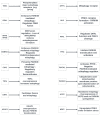The Role of Mitophagy in Glaucomatous Neurodegeneration
- PMID: 37566048
- PMCID: PMC10417839
- DOI: 10.3390/cells12151969
The Role of Mitophagy in Glaucomatous Neurodegeneration
Abstract
This review aims to provide a better understanding of the emerging role of mitophagy in glaucomatous neurodegeneration, which is the primary cause of irreversible blindness worldwide. Increasing evidence from genetic and other experimental studies suggests that mitophagy-related genes are implicated in the pathogenesis of glaucoma in various populations. The association between polymorphisms in these genes and increased risk of glaucoma is presented. Reduction in intraocular pressure (IOP) is currently the only modifiable risk factor for glaucoma, while clinical trials highlight the inadequacy of IOP-lowering therapeutic approaches to prevent sight loss in many glaucoma patients. Mitochondrial dysfunction is thought to increase the susceptibility of retinal ganglion cells (RGCs) to other risk factors and is implicated in glaucomatous degeneration. Mitophagy holds a vital role in mitochondrial quality control processes, and the current review explores the mitophagy-related pathways which may be linked to glaucoma and their therapeutic potential.
Keywords: genetics; glaucoma; glaucomatous neurodegeneration; mitochondria; mitochondrial dysfunction; mitophagy; primary open-angle glaucoma.
Conflict of interest statement
The authors declare no conflict of interest.
Figures


References
-
- GBD 2019 Blindness and Vision Impairment Collaborators. Vision Loss Expert Group of the Global Burden of Disease Study Causes of Blindness and Vision Impairment in 2020 and Trends over 30 Years, and Prevalence of Avoidable Blindness in Relation to VISION 2020: The Right to Sight: An Analysis for the Global Burden of Disease Study. Lancet Glob. Health. 2021;9:e144–e160. doi: 10.1016/S2214-109X(20)30489-7. - DOI - PMC - PubMed
Publication types
MeSH terms
LinkOut - more resources
Full Text Sources
Medical

